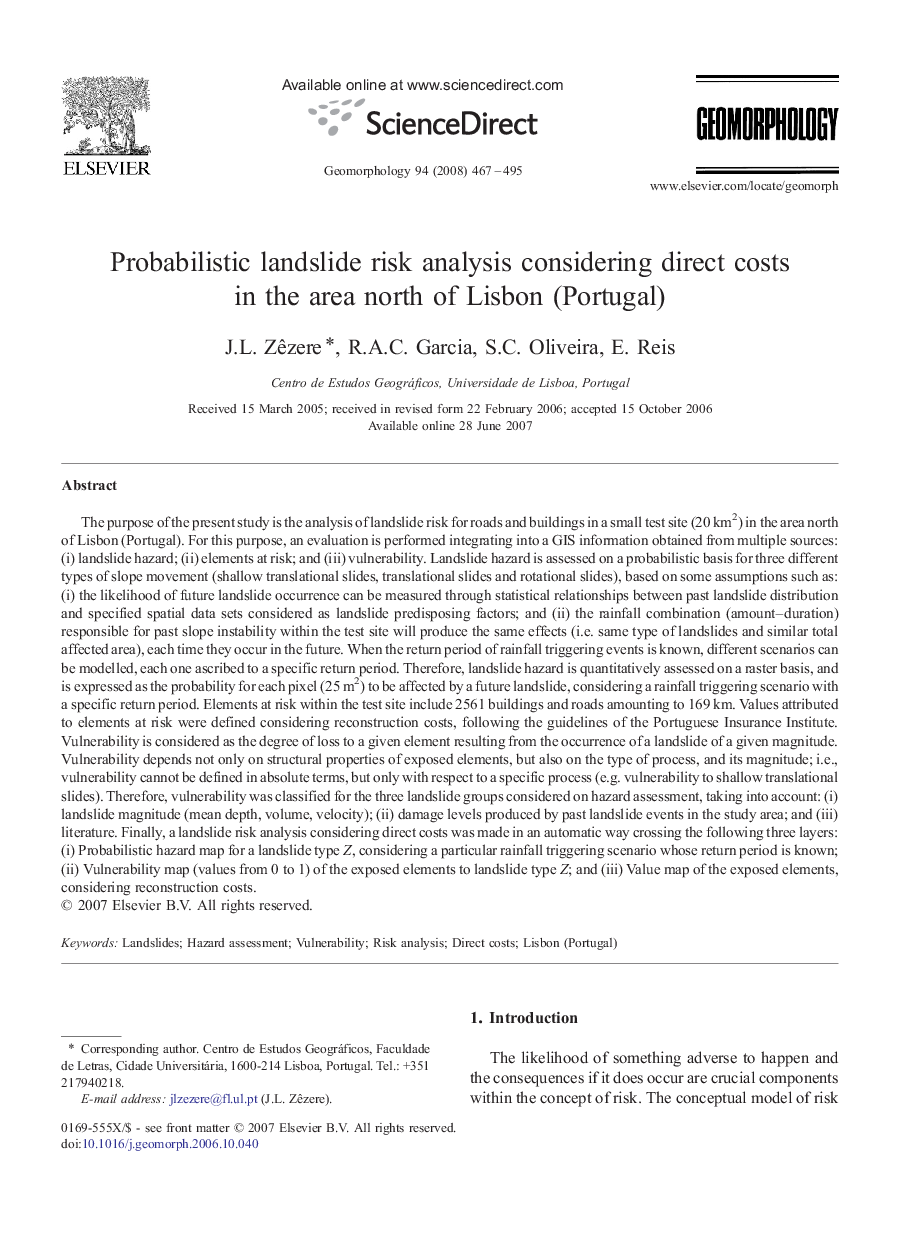| کد مقاله | کد نشریه | سال انتشار | مقاله انگلیسی | نسخه تمام متن |
|---|---|---|---|---|
| 4686851 | 1635564 | 2008 | 29 صفحه PDF | دانلود رایگان |
عنوان انگلیسی مقاله ISI
Probabilistic landslide risk analysis considering direct costs in the area north of Lisbon (Portugal)
دانلود مقاله + سفارش ترجمه
دانلود مقاله ISI انگلیسی
رایگان برای ایرانیان
کلمات کلیدی
موضوعات مرتبط
مهندسی و علوم پایه
علوم زمین و سیارات
فرآیندهای سطح زمین
پیش نمایش صفحه اول مقاله

چکیده انگلیسی
The purpose of the present study is the analysis of landslide risk for roads and buildings in a small test site (20Â km2) in the area north of Lisbon (Portugal). For this purpose, an evaluation is performed integrating into a GIS information obtained from multiple sources: (i) landslide hazard; (ii) elements at risk; and (iii) vulnerability. Landslide hazard is assessed on a probabilistic basis for three different types of slope movement (shallow translational slides, translational slides and rotational slides), based on some assumptions such as: (i) the likelihood of future landslide occurrence can be measured through statistical relationships between past landslide distribution and specified spatial data sets considered as landslide predisposing factors; and (ii) the rainfall combination (amount-duration) responsible for past slope instability within the test site will produce the same effects (i.e. same type of landslides and similar total affected area), each time they occur in the future. When the return period of rainfall triggering events is known, different scenarios can be modelled, each one ascribed to a specific return period. Therefore, landslide hazard is quantitatively assessed on a raster basis, and is expressed as the probability for each pixel (25Â m2) to be affected by a future landslide, considering a rainfall triggering scenario with a specific return period. Elements at risk within the test site include 2561 buildings and roads amounting to 169Â km. Values attributed to elements at risk were defined considering reconstruction costs, following the guidelines of the Portuguese Insurance Institute. Vulnerability is considered as the degree of loss to a given element resulting from the occurrence of a landslide of a given magnitude. Vulnerability depends not only on structural properties of exposed elements, but also on the type of process, and its magnitude; i.e., vulnerability cannot be defined in absolute terms, but only with respect to a specific process (e.g. vulnerability to shallow translational slides). Therefore, vulnerability was classified for the three landslide groups considered on hazard assessment, taking into account: (i) landslide magnitude (mean depth, volume, velocity); (ii) damage levels produced by past landslide events in the study area; and (iii) literature. Finally, a landslide risk analysis considering direct costs was made in an automatic way crossing the following three layers: (i) Probabilistic hazard map for a landslide type Z, considering a particular rainfall triggering scenario whose return period is known; (ii) Vulnerability map (values from 0 to 1) of the exposed elements to landslide type Z; and (iii) Value map of the exposed elements, considering reconstruction costs.
ناشر
Database: Elsevier - ScienceDirect (ساینس دایرکت)
Journal: Geomorphology - Volume 94, Issues 3â4, 15 February 2008, Pages 467-495
Journal: Geomorphology - Volume 94, Issues 3â4, 15 February 2008, Pages 467-495
نویسندگان
J.L. Zêzere, R.A.C. Garcia, S.C. Oliveira, E. Reis,